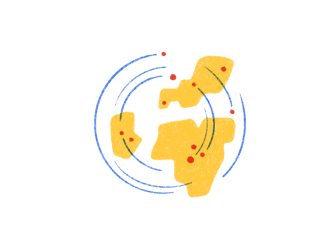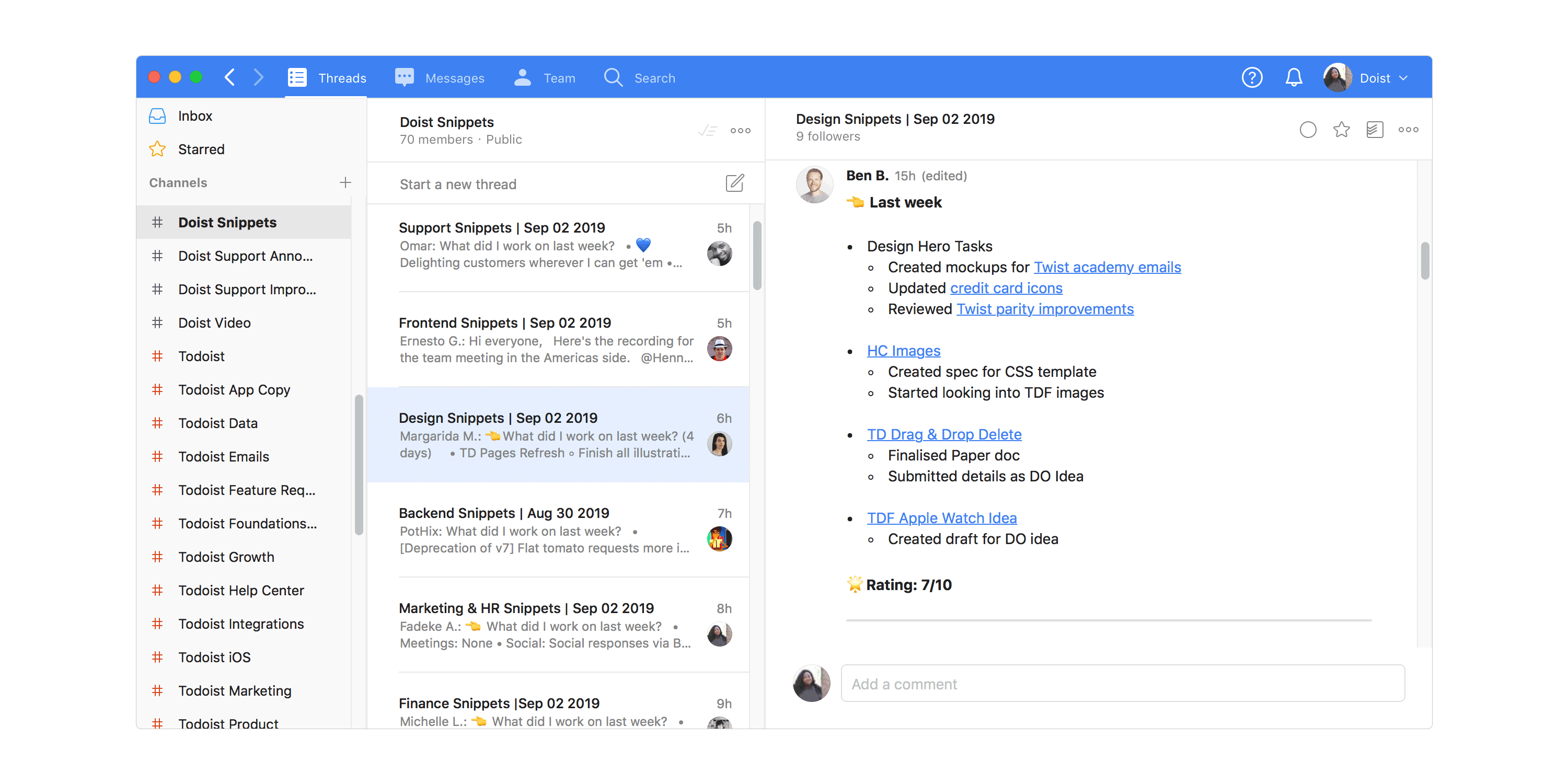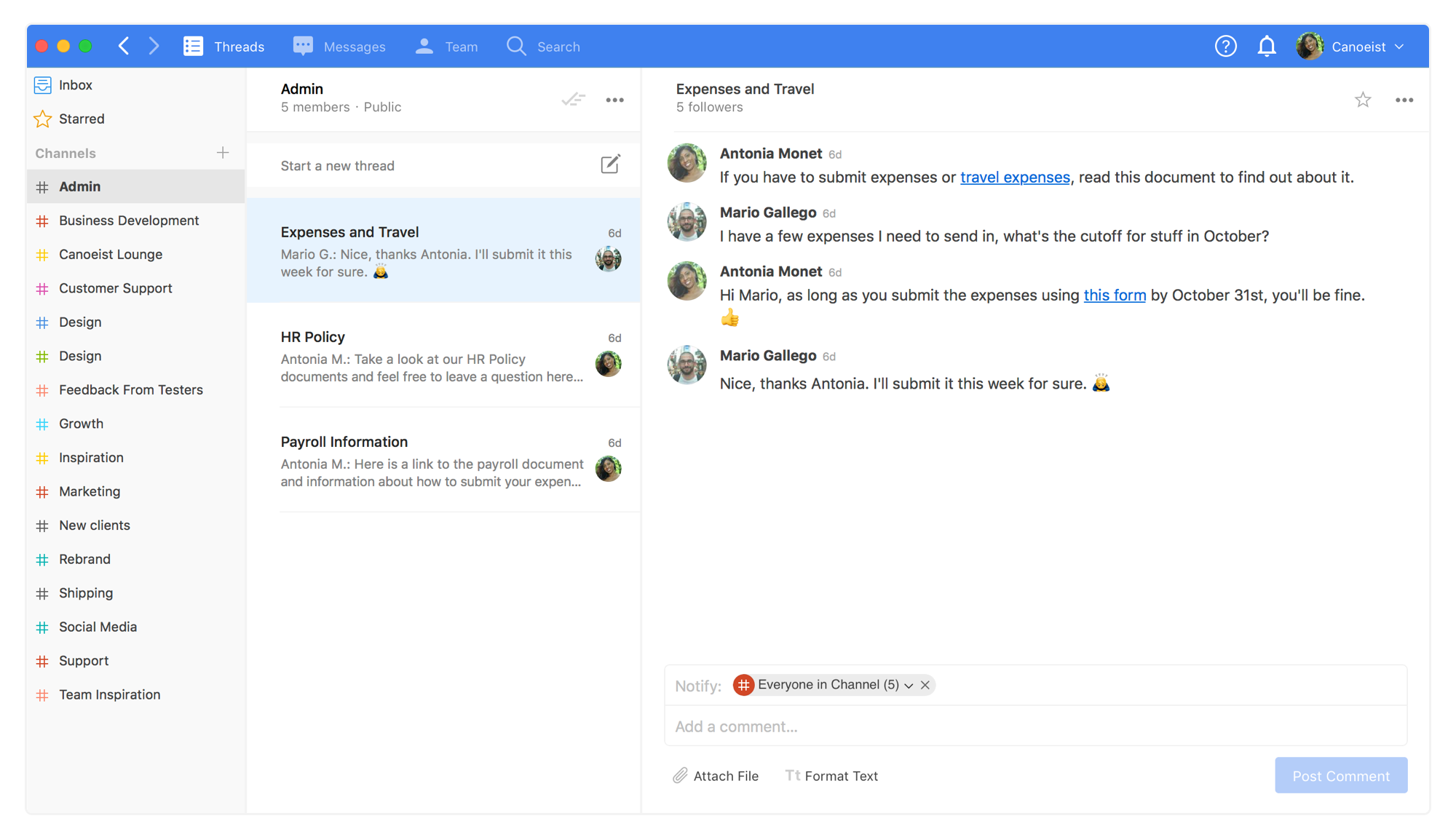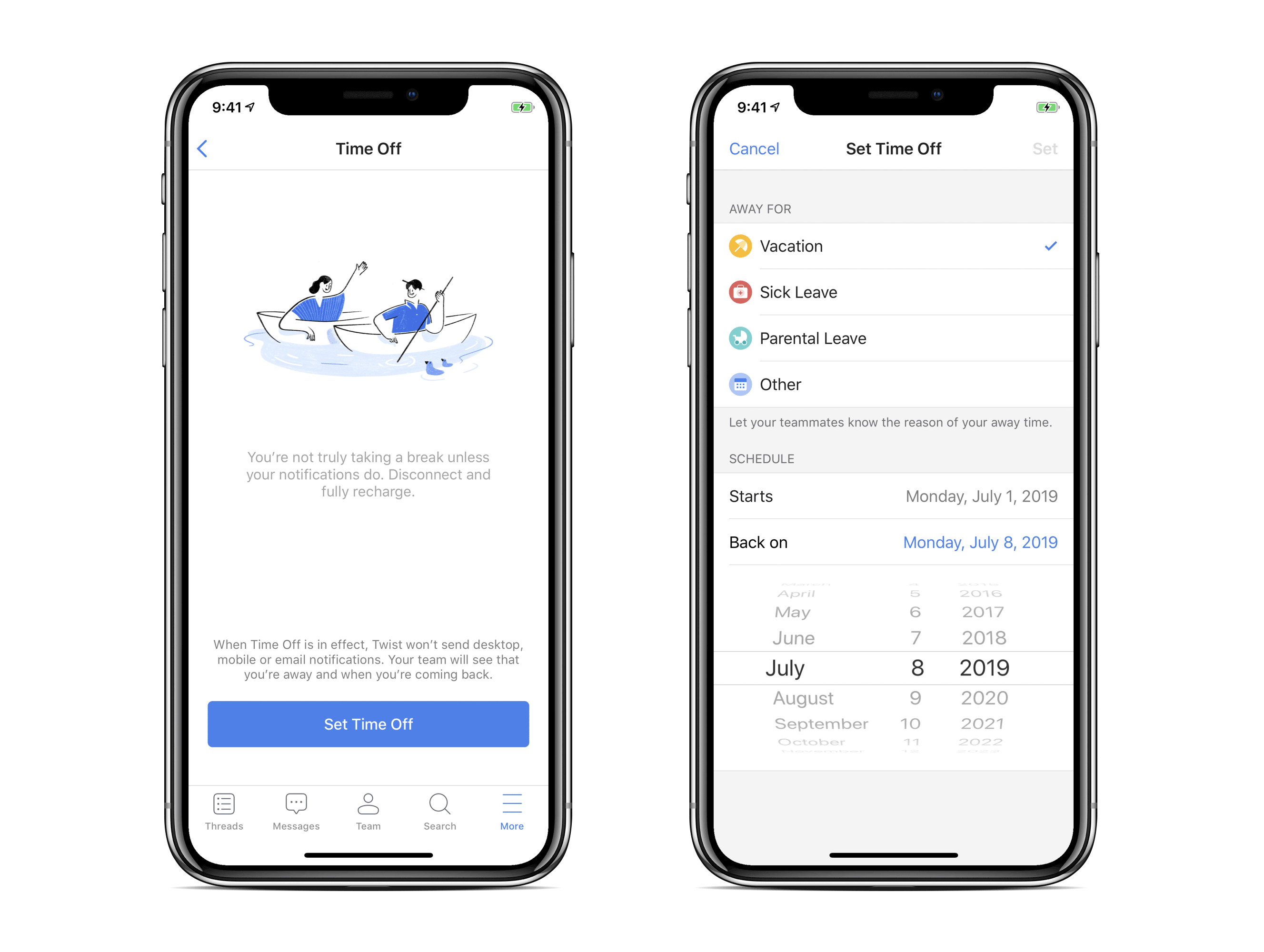Managing a team is filled with both challenges and opportunities. Doing the same on a remote team, where your reports are spread across the world, comes with an entirely new set of demands.
Asynchronous communication: On a remote team, you’ll frequently communicate asynchronously, eliminating the context of tone and body language, and leaving room for misinterpretation and hurt feelings.
Monitoring performance: You’ll have less insight into whether your team members are experiencing burnout or underperforming.
Scaling leadership: It’s not enough to be a leader. You’ll need to develop the leadership skills of your reports so they can make decisions in the absence of someone behind their shoulder.
This guide will demystify managing a remote team and provide insights into leadership methods to follow as you lead your international team. We’ll cover best practices for building and maintaining a strong team culture without an office. We’ll discuss how to identify your blindspots as a remote leader and make time for high level thinking. We won’t shy away from difficult subjects like delivering critical feedback when you’re not face-to-face or saying goodbye to a remote team member.
The only way to get better at being a manager is simply managing others. This is also true of managing a remote team. However, there are hundreds of resources on regular management to help guide the way. Comprehensive resources on managing a remote team are largely absent. Our hope is to bridge this information gap and help leaders at remote companies build, run, and scale high-performing teams across time zones.
Note: Hiring and onboarding are significant parts of management. We cover those topics separately in our Remote Guide to Hiring.
 Defining Success
Defining Success
One of your key roles as a manager is determining what a “win” is for your team. Without knowing what success looks like, you can’t properly lead and your team is left in the dark about why their role matters to the wider company.
In Elad Gil’s High Growth Handbook, Claire Hughes Johnson, the COO of Stripe, makes the following sports analogy to explain the importance of defining success:
“You know why playing a game is fun? Because it has rules, and you have a way to win. Picture a bunch of people showing up at some athletic field with random equipment and no rules. People are going to get hurt. You don’t know what you’re playing for, you don’t know how to win, you don’t know how to score, and you don’t know what the objectives are.”
This is especially important on remote teams. Having team members scattered around the world can inevitably lead to misalignment. Silos can easily form when there’s nobody regularly standing in the middle of the office announcing goals and objectives. Defining what a positive result is, setting explicit goals, and communicating that widely and transparently will set up your remote team to do great things.
Knowing Your Organization’s Goals
One of the biggest concerns around remote work is the lack of chance bump-ins and water cooler moments that can lead to both key information transfer and serendipitous moments. Despite the drawbacks of open offices, someone from Marketing striking up a conversation with a team member from Engineering is often more than just socializing – it can create windows into one another’s processes and alignment on goals across a company’s departments.
Without clear and intentional communication, this can be lost on remote teams. Different departments can work in isolation for long periods of time, only connecting in the final phases of a project. Different leaders can set goals for their team and fail to share them with the wider company.
As a manager, it’s essential to know and understand your company’s goals and where your team fits into the picture. On a remote team, this often means you have to be more proactive about getting this information so you can effectively communicate it to your team.
Maintain open lines of communication with executives. Executives or your C-Suite often set the direction of the company. Maintain close communication with them regarding company goals, key performance indicators (KPIs), and how your team can support these objectives. If they regularly meet, encourage them to share relevant details with the wider team. Also, in remote organizations where transparency and flatter hierarchies are common, don’t hesitate to ask your CEO or CTO to jump on a call to discuss anything you're unclear of.
Regularly check-in with fellow managers. On a day to day basis on a remote team, it can feel like just you and your team. Ensure that you’re making time to set up video calls with fellow managers or catching up with them asynchronously. Stay in the loop about what their teams are working on and how it relates to your own team’s function. Always default to overcommunication and don’t fear asking what seem like “obvious questions (i.e. “So, the purpose of this project is x?” or “How does this relate to the goals set for Q4?”)
Keep goals front-of-mind for everyone. On a remote team, having a single source of truth when it comes to company goals is crucial. Having KPIs and your team’s objectives in a place that’s accessible to the entire team will create transparency and ensure everyone is on the same page. If your team doesn’t have this, approach your executive team about starting this practice.
Creating Short Term and Long Term Goals
When you’re managing a team it’s your job to take your company’s wider goals and translate them into more specific goals for your team. This applies to both short-term and long term goals. On remote teams where people largely work in isolation, goals can be an important unifier that keep everyone motivated and moving in the same direction.
Create ambitious, but realistic, short term goals. Give your team something to work towards that creates real value but doesn’t lead to burnout, a health condition that remote workers are often more susceptible to. Be explicit about who might “own” a particular outcome by defining Directly Responsible Individuals (DRIs). Your reports will often be more attuned than you on whether a particular outcome is realistic, so create goals collaboratively and seek their input before finalizing them.
Construct long term goals. While short-term goals are helpful day-to-day, transparency around long-term goals sets direction for your team and can be essential for increasing engagement. Keeping everyone aware of the company’s vision for the future is important for your reports to contextualize their role and understand what career growth might look like for them over time.
Tracking Performance and Output
If you’re managing a remote team, you likely won’t have information about when someone ends or starts their day, how many hours they’re working, or what a play-by-play of their day looks like. This is a good thing. It means you aren’t relying on shoddy tactics like micromanagement to assess if your team is doing well. Instead, you’re forced to use other ways of monitoring success.
Don’t track hours. At the end of the day, it doesn’t matter if your team member starts the day at 6am or 12pm or puts in a consistent 8 hours/day or opts for a varied schedule. It’s hard to gauge this remotely and attempting to do so isn’t a good use of time or resources. There are tools that can track screens and monitor online movement. However, what you might gain in knowledge about your team’s activities is lost in removing autonomy and trust between yourself and your reports.
Focus on results. Concentrate on outcomes. Keep track of whether a report meets deadlines, produces high quality work, and is communicative. Potential results you could focus on might be the number and quality of blog posts your Marketing Team produces, the % increase of app downloads your Growth Team generates, or the # of tickets your Support Team answers.
Communicating Results
Sharing results within your team and also with your wider team has multiple purposes:
If results are good, you can create buy-in from the wider team if you want to work on bigger and bolder projects.
If results are poor, you can communicate why, share potential areas of improvement, disclose what you’ll be trying next, and seek input from the wider team.
Communicating results on a remote team is yet another way to create alignment and to boost morale or encourage improvements.
Share monthly updates. Post a written update about what your team has been doing at the end or start of each month. Share these widely with your entire team in your company’s communication tool (i.e. Twist, Slack, Microsoft Teams), so everyone is aware of what your team is working on and can ask questions. At Doist these reports adopt the following format: Highlights from previous month → Plans for upcoming month. This includes subsections for specific projects, product details and status updates.
Brag about your team. In the absence of office high-fives and post-work celebrations, finding a way to recognize good work is essential for morale on remote teams. Luckily, this can be done asynchronously too. Call out and bring attention to good work when you see it. If there’s an opening to do the same over a video call or in-person meeting, take the opportunity to do the same.
 Creating Process Within Flexibility
Creating Process Within Flexibility
One of the aspects people enjoy most about remote work is the flexibility. Setting your own hours creates work life balance while choosing where you work is a productivity boon. However, the lifestyle flexibility of remote work shouldn’t extend to process flexibility. In a remote team, it’s more essential to create defined process that add structure.
In an office, you can have quick conversations about how something should be done. On a remote team this ability is reduced. It becomes essential to have explicit rules around how to work that are documented and available for everyone.
Working in Cycles
Remote work requires defined work systems that define your team members’ responsibilities. This means having deadlines, project leads, and work flows that enable regular updates and reporting. Without this in place, projects can drag on for months with no end in sight as people work in isolation. Using project cycles for your team is a good way to erase ambiguity and assign responsibility.
A good work cycle system should include the following:
A list of the team members involved
A definitive start and end date
Clear deliverables
All of these factors serve to build accountability on a remote team. Whether someone is working from their home office or on a beach, their deliverables and delivery date remain constant.
Here are examples of specific work cycles at remote companies:
At Doist, we use four week “DO cycles” and work in interdisciplinary squads to design and develop product features and marketing and support initiatives.
Basecamp, a fully remote company, uses six week cycles to work on product features.
Requesting Regular Updates
When people hear about remote work, they often ask this: “But how do you know if people are working?”. Though this query assumes a lack of trust, it’s a valid question. While it’s important to default to trust and track results over hours, sometimes it can take months before a project is complete or a specific result is realized. In the meantime, it's good practice to have everyone on your team regularly provide updates on their work in some way shape or form.
Share weekly updates. Weekly written updates can provide transparency into what team members are working on and how they’re spending their time. Weekly updates can also link to work in progress or associated discussions that provide “proof” of work. At Doist, every team creates a dedicated Twist thread each week to share “Weekly Snippets”. Every team member is required to post these on Monday morning. As a manager, this is a good practice to see what your team is working on, how they feel they’re doing, and any blockers you can remove that will help them succeed.
Have Weekly Meetings. Weekly department meetings are also a good forum for regular check-ins. They can be quick with everyone sharing brief updates on their work or disclosing any issues they need help with. Unfortunately, these check-ins can be more challenging on remote teams spanning multiple time zones.
| Weekly Snippets |
|---|
|

Creating and Maintaining Documentation
Documentation is crucial for outlining processes and making them available to everyone. They serve as important reminders for current team members and can be of significant help to new team members joining the team. As a manager, creating documentation will clarify process and serve as something you can point to if a team member has a question. Documentation should be clear, concise, and accessible. What should you create documentation for? On a remote team, anything and everything:
| Area | Documentation |
|---|---|
Admin |
|
Content Marketing |
|
Support |
|
People Operations |
|
Engineering |
|
Popular tools for documentation include the following:
Google Docs
Some [comprehensive examples of documentation](https://about.gitlab.com/handbook/) come from GitLab, a fully remote team, who has also made much of their documentation public. A few examples:
GitLab’s CEO and Founder, Sid Sijbrandij noted the following in an interview with InfoQ:
“Employing remote workers can be difficult but we’ve spent a lot of time outlining and constantly refining our employee handbook, which is now a running document that details our internal processes, team resources, and more. Our handbook is the “source of truth” where all vital information is stored. Everyone at GitLab has access to this document and is an easy way for employees to refer back to one document for information about projects in the works or company information.”
 Building A Team of Leaders
Building A Team of Leaders
On a remote team, autonomy is key for a few reasons:
Team members need to stay engaged without someone over their shoulder.
Everyone should feel comfortable making decisions when nobody is online.
Individuals need to remain proactive in the absence of constant direction.
In your role as a manager, it’s important to enable your team to become leaders and managers of one.
Avoiding Micromanagement
Micromanagement can be a natural impulse on a remote team. Without a visible (but faulty) metric of work like “time spent in the office”, you may try to get this information through other methods.
Here are some questions that likely fall under the category of micromanagement in a remote setting:
“What are you working on?”
“Can you provide me with daily updates instead of weekly updates?”
If you’ve done the work of creating process, you should already know what everyone is working on, have a method for collecting status updates, and have regular recurring calls scheduled. Going beyond your established process, to seek out extra information or try to significantly influence your reports’ work and direction, is when micromanagement occurs. This is a guaranteed way to create stress and erode trust on your team.
An article on micromanagement by the Harvard Business Review says this on the subject:
“While micromanaging may get you short-term results, over time it negatively impacts your team, your organization, and yourself. You dilute your own productivity and you run out of capacity to get important things done. You stunt your team members’ development and demoralize them. You create an organizational vulnerability when your team isn’t used to functioning without your presence and heavy involvement.”
Treating your team like adults, and defaulting to trust, will improve how your team functions and avoid leaving people feeling discouraged.

CEO, Remote
Give people responsibilities and independence in decision making, and support them in that. Never micromanage. Listen to what people have to say, and remove obstacles.
Relinquishing Responsibility
As a company grows, it’s your job as a manager to “Give Away Your Legos”: recognize you can’t do everything yourself and hand-off key areas of responsibility to your reports to scale your organization.

Head of Marketing, Doist
As a manager, taking the leap of faith to not just delegate, but truly relinquish responsibility empowers your team members to rise to the occasion and affords them the space to grow creatively and independently (and even fail — which is often when we learn the most).
Be intentional about providing areas of responsibility for your remote team members to reinforce autonomy and strengthen trust. Someone may be less engaged when they feel like a cog in a large machine, particularly when they’re physically detached from others working from home. However, when they’ve been entrusted with a real area of growth and opportunity, they’ll often step solidly into their role and act like a true owner.
Empowering Decision Making
While your role as a manager involves providing direction, there is such a thing as too much guidance. If your reports regularly ask you questions on what they should do and how their work should look, it’s time to improve their decision making abilities.
On a remote team, it’s crucial that team members can make decisions when they’re working by themselves (most of the time). Making a choice and communicating it clearly is an important skill on a remote team where hesitation can significantly slow down projects as you work across multiple time zones.
If your team leans on you to make decisions for them, try these approaches:
Let them know you trust their judgement. Routinely let your team members know that you have faith in their abilities. Instill confidence that they’re capable of making key decisions and driving projects forward without your input (i.e. “I trust your opinion, let’s go with whatever you feel is best”)
Point them to data points to help form a decision. Rather than pointing out the “right choice”, help your team make decisions by pointing them towards data that will help. While decisions can feel tough if they’re based on instinct, adding relevant data can simplify a choice. (i.e. “To help make a more informed decision, look at the results from a similar campaign we did last year.”)
Share a decision making model, not a solution. Teach how to decide, rather than what to decide. If you have personal decision-making models you use, share it with your team. Disclose what factors should come into play when they’re making a decision – for example: potential impact, cost, resources required, unknowns, stakeholder relationships, mission alignment, etc. (i.e. “Rather than focusing on only costs, consider other factors before moving forward.”)
Of course, we’re not suggesting staying tight-lipped everytime a report asks you a question – often a “yes” or “no” will suffice or they might need more information than they currently have. However, if it’s a regular occurrence and the decisions are frequently trivial, these strategies will help strengthen their decision making muscle. Empowering everyone to lead on a remote team builds a foundation of autonomy that will help everyone move more quickly towards important goals.
 Helping Your Team Thrive
Helping Your Team Thrive
A team where people are overworked and undervalued cannot function at full capacity. High quality work won’t be produced when people feel stressed and burned out. Additionally, people won’t invest their efforts into a company that doesn't show appreciation for them.
This is particularly important if you’re working with people across continents as a distributed team. On a remote team, people often have a hard time “shutting off”, leaving room for burnout. Asynchronous communication can sometimes come off as “cold”, making space for negative assumptions to form.
As a manager, it’s up to you to ensure that your team members feel appropriately challenged, deeply respected, and sufficiently supported.
Leading With Trust
Creating a foundation of trust is the first step of creating healthy dynamics on your team. Trust that most people have joined your team with good intentions and are trying their best. Assume they want to simultaneously help the wider team and advance their careers by doing good work.

CTO, Doist
Success revolves around trust, help, and empowerment, not around management in the literal sense of the word. This is true for both co-located and remote companies, but remote makes this especially difficult.
Opt to start off the relationship with trust. When someone starts on your team, they’ve already been assessed and tested during their application process. Don’t create a dynamic where they have to prove themselves to you over time. Extend some level of trust immediately.
Tobi Lütke, the Founder and CEO of Shopify uses a concept he refers to as the “trust battery”:
“It’s charged at 50 percent when people are first hired. And then every time you work with someone at the company, the trust battery between the two of you is either charged or discharged, based on things like whether you deliver on what you promise.”
Trust should only be diminished when someone continually breaks promises and proves that they’re unreliable. At this point, it’s important to let them know how this impacts the wider team.
Trust begets trust; if you praise someone for being reliable, they’ll always try to maintain this standard. If you ignore it, they may feel it’s acceptable and won’t bother improving. More importantly, this attitude can spread throughout the rest of your team and create an environment marked by a lack of reliability.
Practicing Transparency
Working alone on a remote team can lead individuals to speculate in the absence of rapid feedback and reassurance:
I haven’t heard anything about x, perhaps it’s not a priority.
My manager hasn’t reached out in a while, they may be getting ready to fire me.
I haven’t been given access to x documents, maybe I’m not an important part of the project.
To put assumptions to rest, be as transparent as possible as a manager. Answer questions openly and honestly and have discussions out in the open that are accessible to everyone.
Communication tools that are open and searchable (i.e. Twist) are the ideal place to have the majority conversations as a remote team. While you may have private channels for more sensitive discussions (i.e. performance, compensation, restructuring, hiring, promotions, etc) most conversations should be accessible to everyone on your team.
Here are things that often cause unrest that you should be transparent about:
How people are assigned to lead or participate in certain projects
Why certain projects move forwards and some don’t
How promotions and raises are decided
How the company is doing (# of users/customers, revenue, etc.)
The top priorities at the company
The vision for the company for the future
While this serves to quell fears, it’s also a crucial part of enabling your team to do their job. Access to information is key to moving projects forward and contextualizing your role. According to an article by Gallup, transparency is key for providing stability to remote team members:
“Creating a sense of stability among remote employees starts by providing organizational information and data and helping them understand it. Most organizations track their financial metrics -- sales, revenue, profit and stock price -- closely. As this information becomes vailable, provide it to remote workers on a predictable schedule.”
Remote companies are often radically candid, knowing this is the best way to reduce the overhead of opacity:
At Doist, about 95% of internal communication is available to view by anyone at the company in Twist.
Buffer is highly transparent with their team (and the public) about individual salaries, growth and revenue numbers, internal processes, and more.

Transparency can be tough, and there’s certainly a risk of oversharing. However, being truthful about the ins and outs of your company only serves to increase engagement on your team.
Knowing Their Workload
Being aware of your team member’s workload shouldn’t be too hard, right? After all, you assign them work or approve the projects they propose. Unfortunately, it’s not that simple.
Small tasks can pile up. While your report might have a few larger tasks they’re working on, it’s likely that you assign them small tasks here and there that they quickly say “yes” too. Unfortunately, these tasks can add up over time and compete with the more prominents tasks on their plate.
Project scope changes. Often a project starts as one thing and evolves into another. Something that was expected to take a few weeks will now take months. Worse yet, scope may increase but your team member may attempt to squeeze in dramatically more work in the same time frame.
Other teammates assign them work. You may not even be aware of things that have been assigned to your team members. If another manager assigns them something to do, they may be hesitant to say “no”, even when they’re overworked and opt not to tell you about it.
All of this can be mitigated through a few practices:
Request that your reports include everything they’re working on, big and small, on their weekly reports.
Stay abreast of scope creep in the projects your team members are working on.
Let your team members know it’s okay to say “no” to work, both from you and others. If they’re uncomfortable doing so with other managers, step up as an advocate for them and decline on their behalf.
Ask fellow managers to check with you before assigning work to your team members.
These practices will give you greater insights into your report’s workload and help you adjust their responsibilities if they’re at risk of remote worker burnout.
Providing Critical Feedback
Often you’ll need to troubleshoot problems on your team. The best way to do this is with open and honest feedback. Whether you need to address poor performance or redefine a role, providing guidance on how your report can improve and suggesting a path forward is crucial.

Engineering Manager, Stripe
I repeat, probably every week, "a development area isn't pointing out how you're terrible". It's a way to go from good to great. We start out good. We all got hired, we all work together, and we all have room to improve. My goal is to normalize discussions about how we're doing and see everything as a conversation between people who are motivated to get better.
On a remote team, you can provide feedback asynchronously, in a message, or synchronously, over a video call. Use your best judgement on the best medium for a particular piece of feedback to be delivered. If feedback is quick and isn’t part of a wider problem about their performance, a message is usually fine. If feedback related to more serious issues and more action is required, save your feedback for a 1:1 where you can be more emotive and sensitive in addressing the issue.

CEO, Remote
Quick back and forth can work better synchronously. Depending on the participants and the subject, you might need to be able to 'read the room' a bit more than regular, which is easier synchronously than when reading what someone wrote. Anything related to job performance is likely better done synchronously, as to be able to quickly address any misunderstandings.
Here are best practices for providing feedback on a remote team:
Employ radical candor. Kim Scott’s Radical Candor suggests the following heuristic for effective management: “Care personally. Challenge directly”.This method asks managers to be deeply empathetic with their reports, but also to give them direct and honest feedback instead of letting poor performance continue. The beauty of this method is that it allows you to course correct with a report by being direct, while also demonstrating your personal stake in seeing them succeed. This management style is juxtaposed by what Scott describes as the most common and ineffective management style: “ruinous empathy”. With this flawed method, managers show they care, but fail to be honest about a report’s shortcomings, ultimately setting them up to fail. Use radical candor and give your reports the chance to improve rather than letting them to continuously falter and fail.
Point to specifics, not them. If you’re providing critical feedback to one of your team members, ensure that you’re pointing to particular examples that need improvement or could have been handled differently. Rather than applying negative qualities to them as a person, simply describe an example from your point of view. Don’t say “You are continuously being rude”, say “I spotted a comment where you could have been kinder in your response. I understand how the recipient might interpreted these words as unkind.”
Don’t blame, investigate. Instead of saying “You really need to improve your time management skills” note “I noticed you’ve missed a few deadlines like x and y. Are you currently overloaded?” Often you might be seeing symptoms of an issue, not the issue itself.
Praise publicly, criticize privately. When a team member does great work, acknowledge it both personally and publicly. However, always stick to private criticism if you spot something that needs to be addressed, link to it and discuss it in a private message.
Find empathetic solutions together. It’s not enough to just provide feedback. Feedback needs to be coupled with as solution and next steps. Often a report may not fully understand where they made a mistake. Suggestions on a path forward can bring clarity to this. Come up with a solution that works: this could be reduced responsibilities while they struggle with a personal issue or burnout, a performance improvement plan (PIP) that has realistic and achievable goals, or simply working on modifying a behaviour. It’s important that you come up with a solution collaboratively so they don’t feel unhappy or forced into a corner. On a remote team, this conversation is often best had over a video call rather than through message. Additionally, ensure that you don’t leave your team member in some kind of performance purgatory, where they’re anxious about the feedback they received. Immediately when you notice an improvement, acknowledge their hard work in taking the feedback to heart and remove them from a PIP or revert to giving them more responsibility or more autonomy.

Head of Marketing, Doist
Critical feedback needs to be delivered in a timely manner – do not wait for a monthly 1:1. Otherwise, negative feelings could linger and end up producing an unhealthy work dynamic. Also, it’s important to document critical feedback in some way so that the person on the receiving end knows exactly how they can improve in the future. You should offer clear examples on what should be done in the future and offer the person the space and time and extra hand-holding that they need in order to improve.
Providing feedback gets easier with practice and you’ll learn what works and what doesn’t when it comes to delivering advice on improvement.
Encouraging Balance
Remote work can often blur the line between your personal life and work, especially if you work from home. Your home office may be a few steps from your bedroom or you might even work from your dining room table.

Engineering Manager, Buffer
Developers will tend to over-work, to prove to their managers that they weren’t taking advantage of remote work and watching Netflix. Managers often worry about productivity, and whether remote folks will work as hard. The data shows that remote workers are much more productive, tend to work longer hours, and are more prone to burnout. So 'how do I know they’re working" isn’t the question you need to worry about. It’s "how do I know they’re getting enough rest".
As a remote manager, creating balance on your team is necessary to ensure members of your team are happy, healthy, and capable of high quality work.
Set a well-balanced example. Company culture often trickles from the top to the bottom. As a manager, lead the effort for balance. Take vacation days, don’t send work messages after hours (i.e. 6PM) or on weekends or holidays. Share about your hobbies and interests and set the standard of what balance looks like. Don’t fake an image of balance yet work for hours on end in secret. [See our “Working on Yourself” section]
Encourage your team to use their vacation time. Encourage your team to take vacations whenever they need to in order to avoid burnout and stay refreshed. Monitor your team’s vacation booking tool (i.e. Timetastic) to see if everyone is taking vacation in regular intervals. If not, probe them about when their next vacation is planned. This can be especially important if your company has “unlimited” vacation time, where people often feel less included to use their allotted time-off.
Call out and curb unbalanced behavior. Small behaviors can add up over time and become the norm. If a team member is starting conversations on the weekend,privately tell them to stop and maintain more regular hours. Explain that this can lead to feeling overworked in the long-run and also encourages other teammates to do the same, thus creating an “always-on” work culture.
Provide perks that encourage balance. If your company can afford extended perks, choose extras that also happen to encourage balance. For example, Doist has a fitness perk that encourages physical activity, a healthy snack perk to promote wellness, and a co-working perk that minimizes the expense of building healthy social ties in a work environment. Work with your Human Resources team to introduce perks that support balance. These perks demonstrate the importance of maintaining work-life balance and preventing work fatigue and exhaustion.
Institute mental health days. Despite raised awareness of mental health issues, they remain stigmatized in the workplace. Talk openly about mental health at your company and allow for “mental health days” that are separate from or fall under sick days. These should be no-questions-asked days that a team member can take when they need too.

Engineering Manager, Stripe
It's not uncommon to do some sort of wellness check in in our group meetings and 1:1s. I ensure I'm there to really listen and not try to offer solutions. Hearing people out means they're more willing to share. Something I'm personally working on is being more open myself. When someone in a position of authority says, "I'm not well and struggling" it sends a signal that it isn't shameful. There are always some issues people won't bring up at work or to a coworker, though, so sometimes it's just acknowledging something is off in the interactions and giving some space.
Never let unhealthy behaviour fester and create an unhealthy workplace. While your team’s output is important, it should never be at the expense of physical or mental health. Create an environment where your team can thrive both professionally and personally.
Creating Career Paths
Most people seek out career advancement and development in their professional roles. Creating paths for people to progress is key for maintaining job satisfaction. An article in Harvard Business Review on employee career paths notes the following:
"One of the drivers of turnover is easy to overlook: allowing workers to stagnate in their current role. Even after controlling for pay, industry, job title, and many other factors, we find workers who stay longer in the same job without a title change are significantly more likely to leave for another company for the next step in their career."
Despite how satisfying remote work can be, these same sentiments apply. Working as a manager to create a defined career path for your team will minimize anxieties about professional stagnation and career limbo.
Building career paths can be incredibly complex, everchanging, and may even require outside consultation. However, here’s a few key points to keep in mind:
Build career tracks for individual contributors and managers. Not everyone wants to be a manager, so this shouldn’t be the only available path forward. Create different career tracks where progression indicates increased seniority and pay, but roles and responsibilities look different.
Create a defined process for promotion. Who gets promoted and who doesn’t shouldn’t be a black box. Have a defined process so your team members know the steps they need to take to ascend to a new level. At Doist, we have a document outlines our overall “Doist Career Path”. The document includes the following note on transparency: “The goal with an official career path is also to increase the transparency around expectations and opportunities. It should be clear to anyone what their career opportunities at Doist are.”
Have performance reviews. Separate from your regular 1:1s, performance reviews can occur 1-2 per year and are an opportunity to consider your team members for promotions. It’s impossible to remember perfectly what every person on your team has done in the last six to twelve months. Encourage them to come armed with a “brag document” where they can provide an in-depth list of the recent work they’re most proud of.
Providing opportunities for advancement on a remote team is key for employee engagement. It will go a long way in helping your team members envision a future at the company.
Building a Great Company Culture
One of the more commonly asked questions about remote work is how to build a robust team culture. Culture in an office setting has been conflated with many of the “in-person” activities that can build camaraderie: ping-pong tables, video game rooms, and after-work drinks. As a manager, how can you build culture in the absence of an office?
Luckily, company culture is more complex than it might appear on the surface and isn’t limited to in-office movie screening or corporate events. An article by Gallup describes company culture as follows:
“Culture is a critical part of an organization's identity. Culture is created through the experiences that employees have with the corporation and, just as importantly, with each other -- the everyday interactions with peers, managers and executives.”
These interactions can happen anywhere, both face-to-face and virtually.

Culture includes every touch point between your team members and the people and processes at the company: conversations about work, how feedback is delivered, and which voices in a company are amplified or ignored. Positive interactions help build a positive company culture, while negative ones lead to a negative company culture. Managers on remote teams play an important role in setting and maintaining culture that shouldn’t be taken lightly. You establish culture whether you’re aware of it or not; being intentional about this process will yield a happier team.
Celebrate professional success virtually. When someone on your team delights a customer, leads a successful project, or brainstorms and builds an interesting feature, their success should be celebrated. Start a new conversation in your team’s chat or communication tool to bring awareness to a job well done. Alternately, bring up this achievement in a team video call. Make a note of their great work so you can also bring it up at your next 1:1 meeting with them. Often these small gestures are extremely meaningful to employees.
Get personal. If you’re working remotely, it’s easy for your reports and team members to feel like avatars. Sharing personal details about each other’s lives can be beneficial in forming closer bonds. At Doist, we routinely post photos of our weekends and vacations, share news about weddings and babies, and chat about our favorite books, films, and music. Parents at our company have a dedicated channel to discuss everything related to child rearing. Personal discussions help team members feel more connected. However, participation in these types of conversations should be viewed as optional, not mandatory. While some people are open books, others are deeply private. Differences like this should be respected.
Meet-in person. One of the best forums for culture building on remote teams are team retreats. Doist does an annual retreat and also has smaller department-based meet-ups once a year too. Buffer regularly organizes remote work retreats. Team retreats at remote companies are a wonderful opportunity to meet old and new team members, connect in-person, and learn more about the people behind the username. If budget permits, plan a mini-retreat for your team once a year. Create an agenda for the retreat that includes time to discuss large goals and direction, specific projects, and also downtime to sight see and socialize.
Maintain a low level of hierarchy. Remote teams are often flatter than other organizations. Despite the existence of Heads/Managers/Leads, it’s important that hierarchy is minimal and everyone’s opinion is valued and heard. In a low hierarchy remote team, everyone should be able to lead short-term projects, pitch ideas directly to the team, and make company suggestions without the need to “go through channels” or “bring it up the ladder”. This is important on a remote team where autonomy is key and will be a driving force of progress at the company.
Address toxic behaviour immediately. One of the detractors of culture is bad behaviour. This can manifest in the form of abusive comments, discriminatory actions, sexual harassment, innapropriate conduct at team gatherings, and more. Unfortunately, some of this behaviour may arise at your remote company. It’s possible for team members to send lewd comments over team chat tools or to act unprofessionally at team retreats. Your role as a manager is to never ignore this behaviour. Identifying inappropriate conduct, or investigating once it’s reported to you, is essential for fostering a team environment where everyone feels safe and respected. Work with your Human Resources team to find routes for addressing inappropriate conduct including verbal and written warnings, training, demotions, or termination. A way to mitigate these issues before they arise is to have a strong code of conduct at your company. For instance, GitLab has a Code of Business Conduct & Ethics that applies to all employees and includes sections on topics such as “Non-Retaliation”, “Discrimination”, “Harrassment” and much more. Creating a code of conduct, and acting swiftly when team member’s break it is key in preserving a positive and respectful culture.
 Communicating Effectively
Communicating Effectively
One of the toughest challenges of remote work is communication. Much of your conversations with your reports will happen asynchronously through writing. While video conferencing tools are plentiful (i.e. Zoom, Google Meet, Appear_In), video lagging and glitches are common, disrupting the flow of conversation and removing some of the nuance of in-person conversation. Navigating these communication issues is key to effective collaboration, project management, and team trust. Having a strong foundation of communication on your remote team is invaluable for thriving and innovating as a team.
Note: this section will cover remote communication as it pertains to management. Check out our Remote Guide to Communication for a comprehensive resource on this subject.
Creating a Management User Guide
“User guides” or “ReadMes” are an increasingly common practice in management. They’re a document that describes precisely how you work to your reports in an effort to remove ambiguity and collaborate more smoothly. This report is dissmentated from a manager to their reports.
In a management article by First Round Review, the objective of a user guide is described as follows:
“The goal of a user guide is to set blindingly clear expectations on how to collaborate without extra second guessing. The reality is that we all could use some level of assurance, regardless of how well we think we read people.”
A typical manager's user guide might include the following:
Your general philosophies on work and collaboration
Your preferred form of giving and receiving feedback
The specific hours you work each day
Your preference for involvement in projects
How to book a meeting with you
How you would like reports to format reporting
How you can best help your reports with their careers
This practice is rather polarizing, with both managers and individual contributors split on whether this practice is self-aggrandizing or helpful.
However, in the context of a remote team where documentation is king, user guides can be incredibly helpful is setting expectations and knowing how to work with a manager when you’re not in an office together.
A remote work focused ReadMe from a manager to reports should include details about communication and set expectations clearly.
Here are some ideas of what you should include in your management user guide as a remote leader:
The hours you’re online each day: “I start each day at 9AM PST and end each day at 6PM PST. I generally take an extended mid-day break to go to the gym and eat lunch. If you send me a message in your timezone after I end the day, I’ll respond to it first thing in the morning.”
Your management communication style: “I respond to messages rather quickly so I can unblock your work as quickly as possible. If I need more time to think of the response, I’ll respond with a ‘I’ll get back to you on this!’ and respond a bit later. If you don’t hear from me, please ping me again, but I’ll try not to make this a habit.”
Your expectations on remote communication: “I do not expect rapid responses from my team. It’s my hope that you have long stretches of interrupted time for deep work throughout the day where you’re not checking messages. However, I do expect a response within 24 hours. I will ping you again after this time period.”
Your preferred length of video meetings: “If you’re booking a meeting with me, default to 30 minutes and use my Calendly link here: https://calendly.com/…”. Please add the video link to the meeting ahead of time. Our 1:1s are an exception, I will schedule those and they will always be 60 minutes once a month.”
The software tools you prefer to work with: “If you’re giving me something to review, please send it over in Google Docs, so we can use tracked changes. Book meetings with me using Zoom.”
Sharing your concerns: “If you have concerns of any kind, please don’t wait until our 1:1 to bring them up. Send me a message in Twist about it or book a meeting with me to discuss further.”
How to ask for your opinion on something specific: “If you want my feedback about ongoing work, please provide me with context beforehand. Avoid mentioning me in the middle of a conversation with “@Leah thoughts?”. I can’t effectively provide you with feedback this way!”
Write a user guide after you’ve reflected on exactly how you work. Incorporate some of the feedback you’ve gotten as a manager and be honest and open about your expectations. Removing the mystery around how your reports will work with you can ease anxieties and make collaboration easier.
Master Asynchronous communication
Asynchronous communication is the best way to communicate as a remote team.
Asynchronous communication includes every form of communication that don’t happen in real-time where responses can occur intermittently. Examples: team communication tools like Twist, emails, document comments (i.e. Google Docs).
Synchronous communication include every form of communication that happens in real-time where responses occur immediately. Examples: chat tools like Slack, video calls, phone calls, and in-person conversations.
Synchronous communication has its place on a remote team. It can be valuable for socializing, quick back-and forths, and working through complex issues face-to-face. It’s also a good option for emergency situations, like when your company’s product experiences unexpected downtime. However, it often isn’t a viable option at remote remote companies for all scenarios. Time zones throw a wrench in remote team conversation: it’s tough to jump on a video call when its Friday at 10:30 am in Edmonton, Canada and Saturday at 2:30 am in Adelaide, Australia.
Asynchronous communication is ideal for remote teams because it doesn’t require two people to be online at the same time. Instead, someone in Boise can respond to someone in Beirut in their respective time zones and collaborate “out of sync”.
Asynchronous communication also encourages deep work. In the absence of constant notifications from group chat and endless meetings, your team members will have the time to do immersive work for long stretches of time.
However, asynchronous communication comes with downsides. Without care, text communication can appear cold and unfeeling. Long responses between messages can inadvertently create distrust. Understanding these pitfalls will help you avoid them as you navigate asynchronous communication with your team.
Respect response times. You should already have established remote communication ground rules with your team members. It’s important to abide by them. If you’ve outlined that you expect a response in 24 hours, don’t ping them before this time has passed unless there’s an emergency. On your end, don’t leave your report’s hanging for too long after they’ve messaged you. It’s not uncommon for team members to jump to assumptions when they don’t receive a timely response.
Default to overcommunication. Typing messages back and forth comes with some overhead. It’s easy to default to shortcuts and send messages that lack context and details to expedite communication. On a remote team, this is a mistake. On the contrary, you need to over communicate. Assume the things you think are obvious aren’t and what’s implied needs to be made explicit. Details like dates and timezones, people involved, context, and links or mentions of relevant conversations should all be included in the messages you send your team. Leave nothing to the imagination.
Be mindful in your communication. In person, managers can get away with delivering a frank message but finishing off with a smile or a pat on the back in the radical candor style of “care personally and challenge directly”. As a manager on a remote team, you don’t have this luxury. Facial expressions and body language are lost during asynchronous communication. This means you need to take extra care when speaking with your teammates. Bluntness must be softened. Being straightforward and matter-of-fact tends to come off as harsh and unfeeling over text. While you should always be honest, use techniques from resources like nonviolent communication such as “positive action language” and “requests vs demands”. It can be helpful to make qualifying statements and to recognize nuance while writing messages.
Use expressive speech and fun instruments. Another method for diffusing the lifelessness of text messages is using expressive speech, like adjectives and exclamation marks. While this may feel silly or unnecessary, it’s incredibly common for people to feel miffed in the absence of these positive communication indicators: the difference between “okay.” and “okay!” is apparently vast. Other positive communication indicators include emojis and gifs which can add life to plain conversations.
Use the right tool. Using the correct tools will set you up for asynchronous communication success. While a line-by-line chat tool like Slack moves too quickly, something like email doesn’t keep conversations organized and is challenging to scale across an organization. At Doist, we use our thread-based team communication tool, Twist, which enables calm communication across time zones. Other companies have created their own tools: Automattic uses a P2 Wordpress theme for all company communication, while Zapier uses Async, an internal tool they built. GitLab uses their own tool, GitLab, for all company communication. The fact that remote companies gravitate towards building or using their own products for asynchronous communication underscores the importance of getting asynchronous communication right.
Having Video Meetings
When asynchronous text-based conversations won’t cut it, use video meetings instead.
On a remote team, meetings can be complex because they involve multiple timezones. Unfortunately, sometimes there’s no getting around this. For remote team video calls, it’s important to be mindful of time zones and provide accommodations when people cannot attend.

For instance, the Buffer team is spread across the world and has a [monthly all-hands meeting](https://open.buffer.com/remote-all-hands/), but records the call for everyone you can’t attend:
“We schedule the events well in advance using Google Calendar invitations, and we try to position the call so that as many people as possible can make it to the live event, which means prioritizing a time that works for both the U.S. and Europe. That does mean that it can be tough for teammates in Australia and Asia to join in, and we definitely don’t expect folks to wake up in the middle of the night to attend. We always record every All Hands so that whether someone is sleeping, off on family leave or vacation, or just can’t make it for some reason, anyone can catch up on what was shared.”
As a manager, here are a few situations where it’s best to opt for a video call:
1:1 Meetings. Chatting one on one with your reports should occur at least once a month in a face-to-face format like video.
All-Hands Calls. In between your remote team retreats, it’s important to stay connected as a team. All-Hands calls provides a forum to do just that.
Discussing complex issues. If you’re struggling to understand a problem presented to you asynchronously, a live-brainstorm or walkthrough can often be immensely helpful.
Delivering critical feedback or sensitive information. It’s best to provide more serious feedback over video where you can have a more open-ended conversation and inject warmth into what you need to say.
While asynchronous communication will likely make up the bulk of communication with your team, video calls can be used strategically to build morale and work through problems more quickly.
 Terminating Remote Employees
Terminating Remote Employees
One of the worst parts of being a manager is realizing the relationship between a team member and the company needs to come to an end.
Firing someone is never easy and can be a combination of many factors. There may be valid reasons to let go of an employee: feedback on improvement may not have been realized or they may have communication issues that are magnified in a remote setting. However, failures very often lie with the company as a whole and yourself as a manger. Recognizing this and approaching a termination with empathy is crucial.

Head of Remote, AngelList
You hire motivated and capable people ideally. From that point on, you made a mistake as a manager. Either you provided the wrong context, you hired the wrong person for the role, or you've frustrated them to a point where they don't care anymore.
On a remote team, it can be particularly difficult to terminate a working relationship. It will feel cold to say a virtual farewell and simply cut of a former team member’s access to your team’s core communication channels and cloud accounts. From a team morale standpoint, it can also be especially jarring to chat with someone for years online, meet them, get to know them, and simply have their online presence removed from the team.
Despite the challenge, it’s also important to consider why a termination is necessary. This individual may be negatively impacting the rest of the team. Additionally, they’re likely not in the right environment to thrive and can focus on finding a role that might be more suited to their skills. Often remote work can be difficult to adjust to and this person could thrive in an office environment.
However, considering necessity doesn’t absolve you from considering gravity. Letting someone go is tougher for them than it is for you.They’ll need to commence a job search, consider finances, and go through the stressful process of finding a new role. As a company, the financial impacts of a termination should always be mitigated with a severance package. If possible, provide notice. If the person was right, but the role was wrong, help them with their job search by providing them with a positive reference and making introductions for them.
There are no easy tips on making terminations less painful, but they can be done with care and empathy in mind.
Saying Goodbye
Letting go of a remote team member should generally follow all the standard steps of firing someone. In a remote setting, bidding farewell to a team member should be done face-to-face over a video call, rather than asynchronously in writing. There are a few ways to time this:
Their next 1:1 meeting
An impromptu meeting you request with them (same day)
Be firm, state the reason behind their termination, and thank them for their contributions to date. It can be a good practice to include someone from your Human Resources team on the call as well.
Depending on the cause of termination and their tenure with the company, you can give them a chance to write a goodbye message in your team’s communication tool. While you may extend this option, understand that feelings may be raw and they won’t opt for this route.
Revoke access to the tools your team uses (i.e. Google Drive, Dropbox, LastPass, Gmail, etc.) in a timely manner.
Despite the difficulty, following a procedure will minimize impact and help transition an ex-team member and the rest of your team more smoothly.
Letting Your Team Know
A loss to the team can affect morale and leave people anxious around their own roles. Minimize this with an announcement to the team that does the following:
Announce their departure and the reasoning. While often your team might have had an inkling before the termination, do not reveal this news before it is finalized. After that point, start a discussion that announces their former team member’s departure. While the details of a termination should largely remain private, provide a broad reason for why they’re no longer with the team (i.e. “Their repeated lack of communication and unannounced absences are against our code of conduct and created extra workload for their team.”) While terminations can come as more of a surprise remotely, let your team know that feedback was provided repeatedly and their departure comes as a last resort. Reiterate the process of how feedback or performance improvement plans work at the company.
Provides them a means to reach out. If your ex-employee has approved, provide their remaining team members with their contact details (i.e. email, phone number) if they would like to remain in touch.
Extend reassurance about their own roles. Be open and honest about how terminations can affect the mood of the team and use the opportunity to note that the remaining team is doing good work.
Offer a chance to talk. Your team might have questions for you. Offer to book video calls that can clarify any concerns they have and reassure them about the quality of their work and their continued role with the company. Keep it professional and remain neutral about the terminated employee, opting not to provide details about their termination.
State a transition plan for their work. One anxiety that can arise out of terminations is the question of the additional workload for the remaining team. State a transition plan clearly and concisely (i.e. “we’ll be hiring someone in the next month”). Ensure that you reduce the work burden on your team as much as possible and move swiftly to address additional work.
Saying virtual goodbyes can be challenging, but following these steps can help everyone move forward.
 Working on Yourself
Working on Yourself
Managing others isn’t easy. A great manager is highly communicative, deeply empathetic, and incredibly organized. The demands of driving a team forward, while not burning out your team members, can lead to an unintended consequence: burning out yourself.

Engineering Manager, Stripe
At the widest breadth, I supported people across a 13 hour time zone span. It required being really flexible with my schedule, so starting work at 6am (I'm an early bird, so this wasn't bad) and working for a couple hours. I then would break for a bit, then come back to work until lunch, and then work the rest of the day. It took a while to figure this cadence out so I wasn't just working 13 hours myself to stay synced with people.
According to Jim Clifton and Jim Harter’s It's the Manager, "Managers report more stress and burnout, worse work-life balance, and worse physical well being than the individual contributors on the teams they lead."
On a remote team, the risk for burnout is only magnified. Additionally, with your fellow managers also remote, it can be challenging to build a support system of peers on which you can lean on for advice and support.
Remote leaders must take steps to grow as both individuals and managers, while side-stepping burnout and making physical and mental health a priority.
Finding a Management Community
Management can be lonely, particularly if you’re leading a distributed team. Finding peers, both online and in-person, can ease some of this load.
Bond with fellow managers at your company. Regardless of the area you lead, it’s likely that you can relate to and learn from the other managers at your company. A Head of Design will likely understand the management issues a Head of People Operations is facing. A VP of Engineering can relate to the challenges a VP of Marketing is seeing on their team. Lean on your fellow remote managers. Set up virtual coffee chats and bounce problems off them. It can be immensely valuable to have someone who understands your role serve as a sounding board or source of advice. At Doist, all of our Department Heads take part in Leadership Circles facilitated by a third-party. These discussions can make remote management feel less isolating.
Seek out managers at other companies. While relationships with fellow managers at your company are invaluable, sometimes you may want someone to speak with who deeply understands your function and can recognize some of the unique challenges of your role. If you’re a Head of Product Design on a remote team, seek out another Head of Product design at a company you respect and admire – whether they’re remote or not. Make a list of companies you appreciate and use tools like Twitter or LinkedIn to identify the person at the company who has the same role as you. Craft a thoughtful message that includes information about yourself, your role, why you’ve opted to contact them specifically, and extend a request to chat sometime. You’ll be surprised by how often you get a response. The worst case scenario is them saying “no” or simply not responding. You have nothing to lose and a lot to gain. Finding someone in the same role as you in a remote company means they’ll be able to understand some of the challenges that come with working on a distributed team. However, seeking out someone who works on a co-located teams comes with the bonus of exposing you to new ways of working that you could potentially adapt to a remote setting.
Attend conferences and events. In-person events are a great way to break from the online windows of team chat and Zoom calls. They can help you meet fellow managers and have discussions that are difficult to have online. Attend events relevant to your particular field (i.e. Marketing and Sales - Inbound, Design - Adobe MAX 2019, etc). There are also a number of remote work specific events that gather remote leaders together (i.e. Running Remote and 9punto5).
Join online management communities. Online communities on LinkedIn, Facebook, Slack, and more can be a great way to find fellow managers and candidly discuss the obstacles facing leaders. For instance, a community like The Watercooler, billed as “an online community for leaders looking to become better”, is a great forum for these discussions and includes members from companies like Doist, Basecamp, and Sprout Social.
Expanding your peer group will help give you people to lean on when you’re working through issues that are best understood by other managers.
Making Time for High Level Thinking
Between meetings with your team and executives, text back-and-forths with your reports, and working on projects of your own, making time for high-level strategic thinking as a manager is challenging. This is especially the case in a remote teams where an “always-on” culture can mean managers are tied to tools like Slack throughout the entire day. Despite the difficulty of carving out this time, not doing so will keep your team spinning in circles without clear direction and vision. Without time to come up with new ideas and approaches, you’ll fail to fulfill your role as a manager:
"The best managers develop human potential through meaningful work and create a performance-oriented culture for their teams while allowing for the flexibility needed to attend to a full life."
Strategic thinking as a leader means answering questions like the following:
How can we better use x’s talents in y to accomplish x?
Who do we need to hire in the next 5 months to fulfil the vision we have of the company in 24 months?
Where are we experiencing bloat? What are opportunities for addition by subtraction?
What core reasons contributed to falling short of our Q3 targets? How do we course correct?
What changes can I introduce on our team to dramatically reduce stress?
None of these questions can be answered in your 10 minutes between Zoom meetings or while you’re being constantly interrupted by notifications. Strategic thinking and working through tough problems requires stretches of focused time without interruption. But how do you get it?
Take your thinking offline. Spend regular time away from external stimuli. Step away from your computer, put your phone on silent mode and go for a long walk or swim. Often your best thinking will be done in the absence of a podcast humming in your ear. In Digital Minimalism, Cal Newport emphasizes the importance of solitude and argues that its gives us "the ability to clarify hard problems, to regulate your emotions, to build moral courage, and to strengthen relationships." There's a reason your best ideas come to you in the shower: you're alone with your thoughts.
Schedule in non-negotiable time to strategize. Add events to your calendar for blocks of time to strategize that can’t be booked by others. Only schedule meetings around those blocks and take them seriously - don’t move them for other meetings or obligations.
Use task batching. If meetings pose constantly disrupt and fragment your day, limit meetings to certain days of the week (i.e. “batch them together). For instance you can limit meetings to Mondays and Tuesdays, while Wednesday, Thursday, and Friday mornings are blocked off for time to think and plan.
Delegate non-strategic work. It’s often the case that managers work on projects or take on individual contributor tasks alongside their leadership role. This can be a good thing. In Camille Fournier’s The Manager's Path, she describes the importance of Engineering Managers “staying technical” to win the respect of their reports and to avoid losing valuable skills. However, she’s clear on how this can be a balancing act:_“It’s a struggle to figure out how to stay technical as you transition to management. The new responsibilities that come with being a manager (more meetings, planning, administrative tasks) don’t lend themselves to having focused time to write code. It can be hard to work out how to stay in the code when you are pulled in a million directions.”_ If you’re feeling this tension, juggling individual contributor tasks with leadership responsibilities, you likely need to delegate some of the former or hire someone who can take on that work. Ultimately, setting strategy and finding ways to multiply and scale the efforts of your team should be your top priority.
Learning Your Blindspots
Being a manager should be equally about giving feedback as getting feedback. Requesting candid feedback from your reports about your management shouldn’t be something you shy away from.
Critical feedback is an opportunity to improve your management skills and do better for your team.
Positive feedback helps you continue along the right track.
Feedback from your team is particularly important in a remote setting. In an office environment, repeated interactions can make it apparent when you’ve done something a report doesn’t appreciate. Their demeanour towards you may change and you might get a sense they’re not telling you everything on their mind. On a remote team, it’s much harder to detect changes through asyrcnrous text communication and short infrequent video calls may not reveal clues of a wider issue.
Unfortunately, it’s not that easy to get specific performance information from your reports. Often, requests for feedback can yield milquetoast responses:
“No concerns here!”
“Yeah, I’m happy with everything.”
“Complaints? Ah, nothing comes to mind...”
Nothing to worry about then, right? Wrong. It’s important to keep these things in mind when you’re requesting feedback from your team:
Go specific, not broad. Try to ask questions that can’t elicit a shallow response. Rather than asking, “What do you think about me as a manager?” ask “What could I be doing to help you realize your career goals?”.
Understand power dynamics. Even if you have a great rapport and a good relationship with someone you manage, the balance remains the same: you’re the manager and they’re not. It can be intimidating to provide critical feedback to your superior– fear of retaliation is not unfounded. Communicate that any feedback will not be taken personally or result in punishment of any kind.
Anonymity can be useful. Despite reassurances, your team members will likely feel more comfortable providing feedback without their names attached. 360 degree reviews can be a good way to accomplish this. This feedback mechanism collects anonymous feedback from reports about their managers. On one hand, this method can be extremely valuable. On the other, it has its downsides. An article in the New York Times penned by Meg Halverson, a management consultant, noted the following: “_The sheer number of thoughtless, and even mean spirited, 360 reviews I’ve seen has led me to question both their purpose and value._” If you receive feedback that’s well-intentioned and constructive, also make a note to discuss it publicly. This showcases a willingness to hear our feedback that will make soliciting non-anonymous feedback much easier. For example, Doist's Founder and CEO, Amir Amir Salihefendić, shared an overview of his 360 review with the entire team that covered both strengths and weaknesses.

Amir is the founder and CEO of Doist – makers of Todoist and Twist.
Both positive and negative feedback can be used for growing as a person, and a lot of times we are blind what our strengths and weaknesses are.
Making Wellness a Priority
Letting work completely overrun your life is a disservice to yourself and your team. Ignoring your vacation time, working weekends, and missing out on sleep will make you a less effective manager, not a more effective one. Running a remote team shouldn’t mean isolating yourself while you work from home and sitting at a desk for hours on end.
In Jason Fried and David Heinemeier Hansson’s, It Doesn't Have to Be Crazy at Work, they disavow the tenants of “hustle culture” and demand that managers set a good example of a calm and healthy workplace:
“If you, as the boss, want employees to take vacations, you have to take a vacation. If you want them to stay home when they’re sick, you can’t come into the office sniffling. If you don’t want them to feel guilty for taking their kids to Legoland on the weekend, post some pictures of yourself there with yours.”

Finding balance and making health and wellness a priority is key if you want to work for any extended period of time without experiencing burnout. A lack of attention to your own needs will have a negative impact on you as a person and as a manager.
As a Person
You’ll feel demotivated and your job will cease having meaning
You may experience loneliness, depression, or anxiety
Feeling tired and lethargic could become the norm
As a Manager
You’ll be irate and have less patience, making your team feel on edge
Sleep deprivation will impact your ability to make decisions and set strategy
You’ll set a bad example for your team and negatively impact a balanced culture
Make a list of wellness priorities that are non-negotiable:
| Management Wellness Priorities List |
|---|
I will use my weekend to unwind and relax with family and friends |
I will not check my work messages or email between 6PM and 6AM each day |
I will go to the gym midday to get some physical exercise |
I will take at least 3 weeks of vacation each year and won’t work on holidays |
I will not travel for work more than three times per year |
I will work from a co-working space 2x per week to socialize and meet others |
I will read one non-work related book each month |
Creating an explicit list of the healthy behaviours you want to cultivate, and consistently reviewing it, will help you balance your responsibilities as a manager with a personal life that you find healthy and meaningful.
 Conclusion
Conclusion
Management demands a great deal. At Doist, our Founder and CEO, Amir Salihefendić, has outlined the company’s expectations of managers:
We expect our manager to embrace our core values, and lead by example, for example:
They are independent, and others can trust that they'll deliver on time and can keep their word. They can also easily manage their work and remain accountable with little or no direction.
Their communication is clear, concise, and engaging whether explaining a complex idea or providing feedback. They keep others in the loop and never go radio silent.
They're able to take a bird's eye view to pinpoint and then solve issues that have a high impact on our customers, our team, and our company.
The role of the manager combines leadership, communication, and strategy. It’s likely that your own company has similar expectations of you. In this way, managing a remote team often feels like assembling a series of complex puzzles.
To start, you’ll put together all the edge pieces that represent the foundations of good management. Then come the middle pieces, the bits of knowledge that are specific to remote work and much harder to fit together. You’ll learn that some pieces simply don’t go together. There will be a few times where you’ll mutter, “A piece is missing from the box!” Eventually you’ll find it. You’ll complete the puzzle. Success!
But just as you’ve finished one, a new puzzle needs to be assembled. You’ll be managing a bigger remote team, taking on a new challenge, or navigating a different context. Over time you’ll get quicker and quicker at assembling puzzles: you’ll learn from past mistakes, get better at spotting patterns, and apply go-to mental models to streamline problem-solving.
In the end, doing these puzzles is both challenging and rewarding. As you continue along the path of remote team management, you’ll learn to love putting together the pieces and sitting down at the table.

